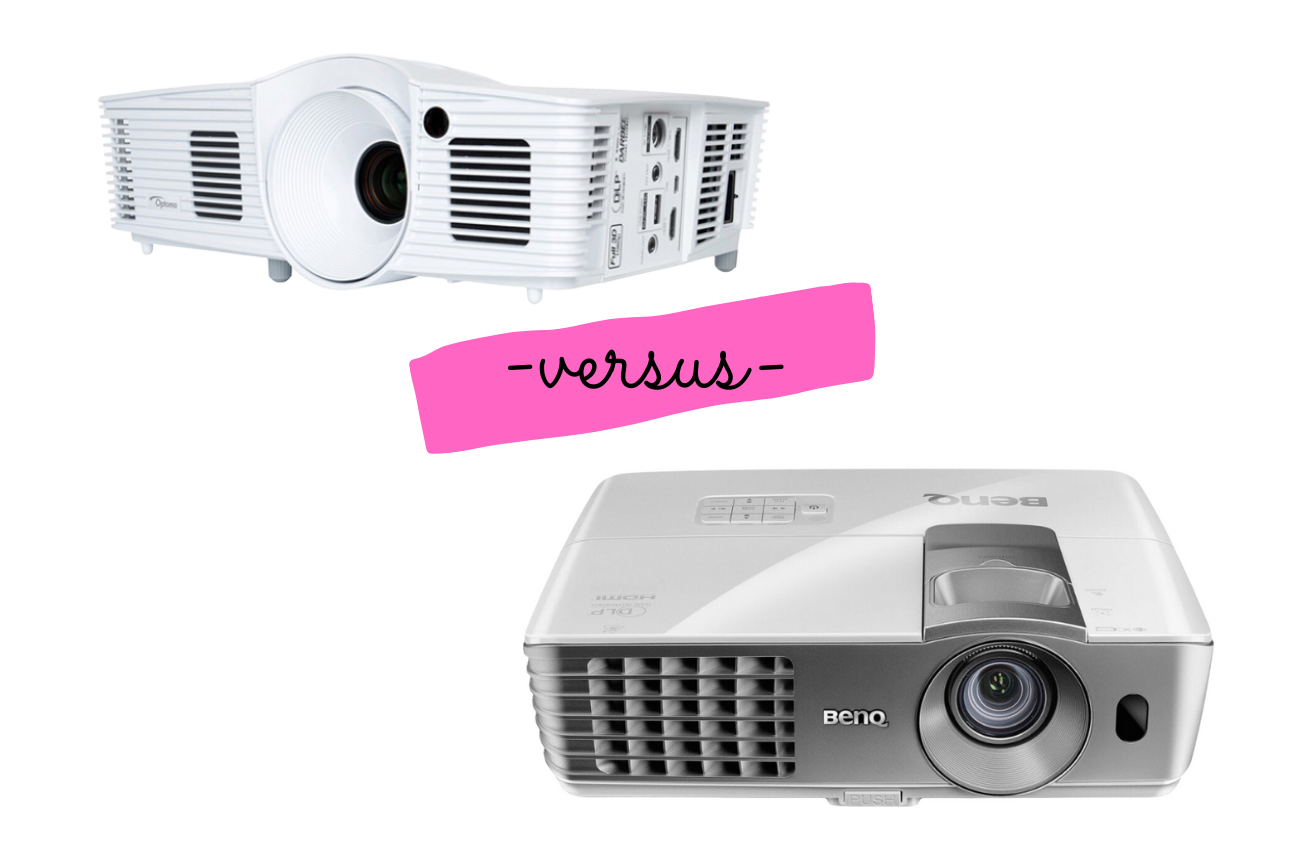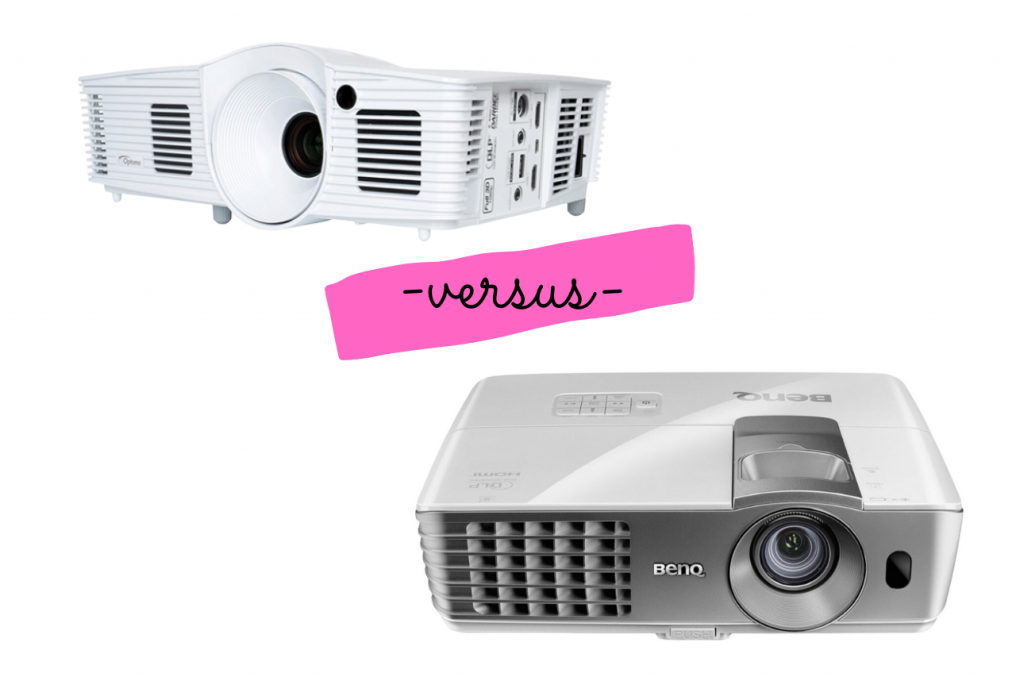
Making a choice about which projector to purchase, can be an arduous task. You know what you want to start out with, and subsequently choose not to buy certain projectors, because they don’t fulfill all of your criteria. But often there are two left, and they seem on the surface, to do exactly the same things, and no matter how hard you try, you simply cannot make a choice between them. Well, that’s what I’m here for, and today we’ll be going beneath the surface, picking apart the special features of the Optoma HD28DSE and the BenQ W1070, so that you can decide for yourself, which is the best one. This is the Optoma HD28DSE vs BenQ W1070 comparison analysis.
TABLE OF CONTENTS
| AAXA P300 | AAXA P450 | |
|---|---|---|
| Brightness | 300 Lumens | 450 Lumens |
| Resolution | 1280x800 | 1280x800 |
| Contrast Ratio | 2,000:1 | 2,000:1 |
| Lamp Life | 15,000 hours | 15,000 hours |
| 3D | No | No |
| HDMI Port | Yes | Yes |
| Aspect Ratio | 16:10 (WXGA) | 16:10 (WXGA) |
| Image Size(cm) | 128 - 308 | 43 - 338 |
| Lens Shift | No | No |
| Speakers | 1.0 W × 2 | 1.0 W × 2 |
| Audible Noise | NA | NA |
| Size(cm) (HxWxD) | 4 x 15 x 10 | 4 x 15 x 10 |
| Weight | 0.6 kg | 0.2 kg |
| Full Review | Read Here | Coming Soon |
| Amazon Price | Click Here | Click Here |
Portability and Design: Optoma HD28DSE vs BenQ W1070
There’s nothing to separate these two in terms of weight. The W1070 comes in at 5.8 pounds out of the box, and the HD28DSE weighs 5.7 pounds out of the box. So the W1070 is heavier, but the difference is so small, that the portability on both should be considered good. The HD28DSE measures 4.33 inches in height, by 12.20 inches in width, and has an 8.66-inch depth. The Benq w1070 meanwhile, measures 4.29 inches of height, by 12.28 inches of width, and comes at a 9.60-inch depth. So again, these two are so close in terms of size, that the difference becomes negligible. Generally, I think both manufacturers have done a fair job here ensuring portability, and no matter which one you choose, you’ll be happy in this area.
Optoma HD28DSE 1080p 3D DLP Home Theater Projector
Performance: Optoma HD28DSE vs BenQ W1070
The set-up for the BenQ W1070 is very easy, as vertical image adjustment is provided, so you don’t have to use the keystone and risk distortion. The Optoma on the other hand doesn’t have vertical or horizontal adjustments, which means you’ll be using the Keystone Correction the whole way. So, if you do choose the Optoma HD28DSE, then please allow a longer time for set-up, and be prepared for complications, with further picture adjustments, for optimum clarity. You read the full HD28DSE review here.
The Optoma is full 3D, which means that when you hook it up to a 3D device, like a Blu-Ray player or a tablet, you’ll be getting glorious 3D images straight away. It includes 3D broadcasting capabilities, so you’ll be able to stream 3D movies without any problems. If you’ve searched on the internet for the w1070, you’ll find it’s listed on some sites, as being ‘Full HD’, and on other sites a being ‘HD Ready’. I’ve been critical of broad terms like these, that companies use to describe products because they don’t explain fully to the customer, what they’re actually getting. ‘3D Ready’ can mean any number of things, but it usually means a system lacks something you’d have on a ‘Full 3D’ projector. In this case, the W1070 has 1.4a HDMI, is 1080p, has a 3D transmitter, and excepts all formats of 3D, so for all intensive purposes, it is a full 3D device. So, if you were wondering, those sites listing it as full 3D are correct because it’s 3D compatible, with 1080p resolution in each eye.
Optoma HD28DSE 1080p 3D DLP Home Theater Projector
The bad news about the W1070 is that it leaks light, and like most single-chip projectors, it delivers light unevenly, so you won’t get all of its promised 2200 lumens. This is a problem BenQ has since solved, with subsequent projection designs, but using the W1070, you’re advised to turn out the light, or watch on a screen of no more than 80 inches. The description from BenQ speaks very highly of a short throw distance from 2.5 meters back of more than 100 inches, but you won’t get a 100-inch screen size unless the room is pitch black or you sacrifice some image quality. The HD28DSE, has 3000 lumens and they largely perform very well, so although its short throw isn’t as good as on the W1070, it’ll definitely look better and brighter at 100 inches in ambient light, than the W1070. Here’s a full W1070 review we wrote last year.
When you get the image in focus, it’s really good on the HD28DSE. They’ve put the Darbee Visual Presence system in, which adds depth and realism to the images, and can display an immense number of colors in great detail. With its 30,000:1 contrast ratio, blacks and whites also look perfect in their sharpness. Although the W1070 has color technology that produces over 1 billion individual colors, its contrast ratio is only 10,000:1, which means blacks and whites aren’t as sharp as on the HD28DSE, and while the w1070 doesn’t have a major problem with distortions, pictures can look noisy, whereas, on the HD28DSE, images look smooth all of the time. The 1080p picture is very good on the W1070, and there are excellent color pre-sets, which means you won’t have to make adjustments to the color settings, but it just doesn’t jump out of the screen at you like the Optoma HD28DSE or even the BenQ HT2050.
Conclusion
The Optoma HD28DSE has a much more difficult set-up, with keystone certainly increasing the likelihood of imported distortions, but if you’re prepared to put in a little effort at the start, it offers a superior picture. The W1070, just can’t compete with the Darbee Visual Presence color technology inside the HD28DSE, and pictures aren’t as smooth, but you’re getting some excellent color pre-sets on a first-class system with 3D, so it comes recommended. It all depends on what you want: Do you want to put in the work and be rewarded with a better picture? if so you should choose the HD28DSE. If you want a very simple system to operate, with color pre-sets that allow you to jump right in and get started, then you should choose the W1070. Thank you for reading.
